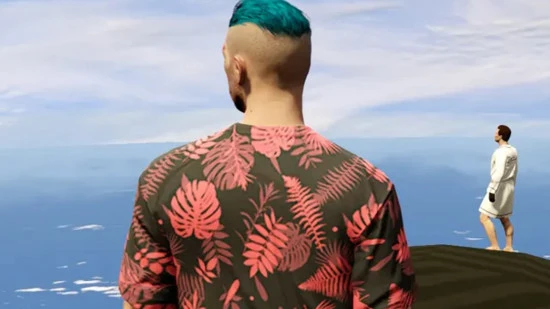There has been no shortage of cinematic responses to the COVID-19 outbreak on screens both big and small. We’ve had found footage horrors (Host), trippy folk thrillers (In The Earth), prestige TV dramas (Help), quarantine shot (anti-)romances (Malcolm & Marie), existential stand-up/musicals (Bo Burnham’s Inside), and even an allegorical arthouse response to self-isolation from Wes Anderson (Asteroid City). But of all the pieces of art to have emerged from lockdown, we can say with confidence that Sam Crane and Pinny Grylls’ Grand Theft Hamlet — a surreal documentary in which two out of work actors mount a production of Shakespeare’s greatest tragedy in the ultraviolent virtual world of Grand Theft Auto Online — is easily the funniest. It also, more unexpectedly, may be one of the most cathartic, too.
Comprising video accumulated from over 300 hours of GTA Online gaming, the first thing that draws the eye when it comes to Crane and Grylls’ film is its strong presentational approach. Going one step farther than this year’s other maverick game-based film, Benjamin Ree’s melancholy The Remarkable Life Of Ibelin, Grand Theft Hamlet is shot and recorded totally in-game – mic crackles, painful respawns, trigger happy trolls, and all. It’s here, in a realm one step removed from reality and yet strangely all the more evocative of that world-within-a-world lockdown sensation, that inspiration hits thespian Crane and fellow actor and buddy Mark Oosterveen.

Hotfooting it from the feds after a light spot of escapist murder, the duo — Crane a family man whose casting in the titular role of Harry Potter & The Cursed Child was thwarted by Coronavirus; Oosterveen an actor with credits on everything from Eastenders to The Ministry Of Ungentlemanly Warfare who lived through lockdown alone — happen upon the empty amphitheatre of Vinewood Bowl, Los Santos. From there, a casual, surprisingly touching, emote-assisted recitation of Macbeth’s “Life’s but a walking shadow…” monologue swiftly spirals into a hair-brained idea to produce a fully-fledged, one-of-a-kind play of Hamlet, performed across the wild and turbulent world of GTA’s false California.
It’s the type of batty concept birthed of two artists’ yearning to keep their creative lights burning — and of two middle-aged guys alternatively busting up from the cabin fever of being housebound with their family and housebound with no family. (This situational disparity between the couple produces a tension at the film’s center that’s most effective when left unstated; when it becomes the foundation for some second-to-third act bridging drama, the film’s layers of artifice become distractingly muddied.)
Read Also: Greatest British Gangster Films
The Hamlet of it all comes to represent a Herculean task for Crane, Oosterveen, and Crane’s roped-in director wife Grylls as they go about casting, organizing, and quite plainly justifying the massive time commitment necessary to carry off their wacky polygonal play. But the unorthodox — bordering on bizarre — set-up creates a comic goldmine for the audience. Taking in bazooka-wielding alien stage managers, audience-butchering blimps, and only sometimes blatantly staged comedic sections throughout its compact 90-minute timeframe, Grand Theft Hamlet retains a sort of double genius. On the one hand, it takes one of the best plays ever written and transforms it into a ‘putting the show together’ comedy of ZAZian proportions (in a just world, alien heavy ParTeb would be a shoo-in for a Supporting Actor nod at the next Oscars.) On the other, it also takes that self-same play and quite brilliantly recontextualises it anew, leaning into the sense of alienation and paranoia felt by Shakespeare’s Danish prince and drawing parallels between that and the experience of living through the uncertainties — the collectivised grief, confusion, trauma — of a global pandemic, all while being kept at arm’s length from our loved ones.

What’s more, buried under the herky-jerky gameplay shenanigans, surprising twists and turns, and spontaneous acts of terrible violence, is an unexpectedly emotional, actually very innovative testament to art’s durability — and value — in times of crisis. This is, after all, the chronicle of two men’s refusal to let the shuttering of theatre doors mean become the curtain call on their craft and on its capacity to reach across the then-all-too-literal divide to bring people together, to offer some light and escape in a time of darkness and oppressive restriction. As Crane so eloquently puts it while escaping a convoy of police helicopters and highly armed lawmen, “You can’t stop art, motherfuckers!” Quite.












